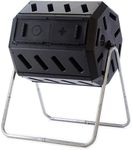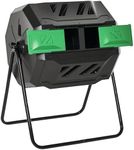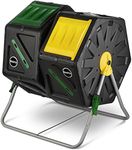Buying Guide for the Best Compost Bins
Choosing the right compost bin can make composting at home much easier and more effective. The best compost bin for you depends on your available space, how much organic waste you produce, and how involved you want to be in the composting process. Understanding the key features will help you select a bin that fits your lifestyle and composting goals.CapacityCapacity refers to how much material the compost bin can hold, usually measured in liters or gallons. This is important because it determines how much kitchen and garden waste you can compost at one time. Small bins (under 50 liters) are suitable for individuals or small households with limited waste, while medium bins (50-150 liters) work well for average families. Large bins (over 150 liters) are best for big families or those with lots of yard waste. Consider your household size and how much organic waste you generate to choose the right capacity.
MaterialCompost bins are commonly made from plastic, metal, or wood. The material affects durability, weight, and how well the bin retains heat and moisture. Plastic bins are lightweight, affordable, and resistant to weather, making them easy to move and maintain. Metal bins are sturdy and pest-resistant but can rust over time. Wooden bins blend into gardens and provide good airflow but may rot if not treated. Think about your climate, where you’ll place the bin, and how much maintenance you’re willing to do when choosing the material.
VentilationVentilation refers to how well air can flow through the compost bin. Good airflow is essential for breaking down organic matter efficiently and preventing bad odors. Bins with built-in vents or slats allow air to circulate, speeding up composting. Some bins have adjustable vents for more control. If you want fast compost and less smell, look for a bin with plenty of ventilation. If you’re composting mainly yard waste, airflow is less critical, but for kitchen scraps, good ventilation is a must.
Access and Ease of UseThis refers to how easy it is to add materials and remove finished compost from the bin. Some bins have wide lids or doors, while others have removable panels or bottom access. If you want to turn your compost regularly or need to remove compost often, look for a bin with large, easy-to-open access points. For those who prefer a low-maintenance approach, a simple top-loading bin may be enough.
Pest ResistancePest resistance means how well the bin keeps out animals like rodents, raccoons, or insects. Features like tight-fitting lids, secure latches, and fine mesh screens help prevent pests from getting in. If you live in an area with lots of wildlife or want to compost food scraps, pest resistance is very important. If you’re only composting yard waste, this may be less of a concern.
Type (Stationary vs. Tumbler)Compost bins come in two main types: stationary and tumbler. Stationary bins sit in one place and require manual turning of the compost, which can be done with a pitchfork or aerator. Tumblers are bins mounted on a frame that you can spin to mix the compost easily. Tumblers speed up the composting process and are less work, making them great for people who want quick results with minimal effort. Stationary bins are better for those with lots of yard waste or who don’t mind a slower process.


















